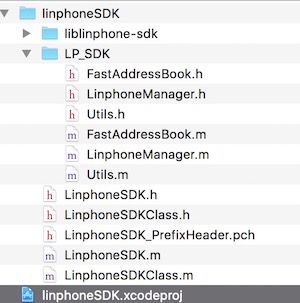背景:需要将 linphone 语音相关功能移植到已有项目中,为了尽可能少移植无用代码,故考虑只移植 linphone sdk 和其必要的调用逻辑代码。
思路:已有项目为 swift 开发,首选将 linphone 移植内容封装成静态库,供 swift 调用。
正式开始前要先吐槽一下 linphone 太过复杂,不经意间就会被绕进去,然后就再也出不来了。还好我只是浅尝辄止,并未过深研究。也许深入后会有新的一片天地,那就看以后有没有相关需要吧!
文献
一般大家写博文习惯将鸣谢和文献写在最后。一是为了不破坏文章整体结构的流畅,二是为了对参考文献原作者的尊重。而这篇博文则将文献放在了开始的地方。这是因为,我不想赘述 linphone 是什么,如何使用,如何移植。需要的话通过下面的链接,你可以获得更多的帮助和启示。
linphone 相关博文:
- 官网:linphone.org
- linphone SDK 官方下载:snapshots-ios
- Linphone-iOS-移植
- 怎样将Linphone移植到自己的项目 值得推荐
我的封装
linphone SDK 封装静态库
通过 xcode 的 File -> New -> Project -> 选择 IOS Framework & Library 下的 Cocoa Touch Static Library 创建一个新的项目。当然这个项目可以是独立的,也可以和你原有项目在同一个 workspace,我的项目是后者。
linphone 静态库工程结构如下图:
这里没什么好说的,基本结构和方法与参考博文 怎样将Linphone移植到自己的项目 中的开源项目基本一致。但由于我的已有项目是 Swift 开发的,并不想使用除 linphone sdk 必须的调用文件以外的其他文件。所以并没有使用 ColorSpaceUtilites,UCSIPCCSDKLog 和 UCSIPCCDelegate(我使用系统通知进行状态更新)。
另外代码中不同的地方有:
// LinphoneSDK 等价于 UCSIPCCManager
// LinphoneSDK.h 添加了micro 和 pauseCall 的操作
@property (nonatomic, assign) BOOL microEnabled; // 是否打开扬声器
@property (nonatomic, assign) BOOL pauseCallEnabled; // 是否打开暂停开关
// LinphoneSDK.m
/**
@author robertzhang, 16-08-02
麦克风状态
*/
- (BOOL)microEnabled {
return linphone_core_is_mic_muted([LinphoneManager getLc]) == false;
}
- (void)setMicroEnabled:(BOOL)microEnabled {
linphone_core_mute_mic([LinphoneManager getLc], microEnabled);
}
/**
@author robertzhang, 16-08-02
通话暂停键状态
*/
- (BOOL)pauseCallEnabled {
bool ret = false;
LinphoneCall *c = [self getCall];
if (c != nil) {
LinphoneCallState state = linphone_call_get_state(c);
ret = (state == LinphoneCallPaused || state == LinphoneCallPausing);
}
return ret;
}
- (void)setPauseCallEnabled:(BOOL)pauseCallEnabled {
LinphoneCall *currentCall = [self getCall];
if (currentCall != nil) {
if (pauseCallEnabled) {
linphone_core_pause_call(LC, currentCall); // 暂停
} else {
linphone_core_resume_call(LC, currentCall); // 取消暂停
}
}
}
- (LinphoneCall *)getCall {
LinphoneCall *currentCall = linphone_core_get_current_call(LC);
if (currentCall == nil && linphone_core_get_calls_nb(LC) == 1) {
currentCall = (LinphoneCall *)linphone_core_get_calls(LC)->data;
}
return currentCall;
}
另外,因为静态库无法打包进资源文件,所以音频文件需要通过bundle进行管理和使用。LinphoneManager 也需要做相应的修改
// LinphoneManager.m 加载音频的地方修改如下
NSBundle *libs = [NSBundle bundleWithPath:[[NSBundle mainBundle] pathForResource:@"Resources" ofType:@"bundle"]];
const char* lRing = [[libs pathForResource:@"ring" ofType:@"wav"] cStringUsingEncoding:[NSString defaultCStringEncoding]];
linphone_core_set_ring(theLinphoneCore, lRing);
const char* lRingBack = [[libs pathForResource:@"ringback" ofType:@"wav"] cStringUsingEncoding:[NSString defaultCStringEncoding]];
linphone_core_set_ringback(theLinphoneCore, lRingBack);
const char* lPlay = [[libs pathForResource:@"hold" ofType:@"wav"] cStringUsingEncoding:[NSString defaultCStringEncoding]];
linphone_core_set_play_file(theLinphoneCore, lPlay);
静态库的创建需要十分小心配置文件的设置,很容易因此被坑到。我就是因为没有在 Compile Sources 中将新添加的文件引入,导致报了很多莫名的错误。当然这和我自己粗心有很大关系。
Swift 使用静态库
静态库引入已有工程中如果出现 xcode 提示 linphoneSDK.a 文件不存在等这类问题,那是因为对于新 clone 的代码,linphoneSDK.a 的引用失效所致。如果 linphoneSDK 工程和已有工程在同一个 workspace,只需要先编译一下 linphoneSDK 工程,然后将生成的 linphoneSDK.a 文件以及必要的 include 文件重新引入即可。具体的步骤可参看:JZPhone 的 README
以上是我在 Swift 项目中对 linphoneSDK 的一层封装
/*
这里用 Delegate 是为了 VOIP 接口的易扩展,VoipDelegate 相当于一个适配器。
当需要接入新的 VOIP 组件,只需要创建一个接口类,并实现 VoipDelegate 协议。
eg: 创建 linphoneSDK.swift ,继承VoipDelegate。通过实现协议中的方法,调用linphone SDK动态库中的 OC 代码完成功能。
*/
/// Voip 组件协议
protocol VoipDelegate {
/// 初始化 voip 组件
func initVOIP()
/// 登陆
func login(name: String, password: String)
/// 登出
func logout()
/// 拨号
func onCall(address: String, displayName: String? , transfer: Bool?)
/// 接电话
func acceptCall()
/// 挂断
func hangUpCall()
/// 获取通话时长
func getCallDuration() -> Int
/// 获取对方号码
func getRemoteAddress() -> String?
/// 获取对方昵称
func getRemoteDisplayName() -> String?
/// 打开、关闭扬声器
func switchSpeaker()
/// 查看扬声器状态
func isSpeakerOpened() -> Bool
/// 打开、关闭麦克风
func switchMicro()
/// 查看麦克风状态
func isMicroOpened() -> Bool
/// 通话挂起
func switchPauseCall()
/// 通话挂起状态
func isPauseCall() -> Bool
}
// CallHelper.swift
class CallHelper {
...
/// 通过协议调用相关操作
static var voipDelegate: VoipDelegate?
...
}
实现 VoipDelegate 协议接入 linphoneSDK
class LinphoneHelper: VoipDelegate {
let domain = "xxx.xxx.xxx.xx"
let port = "xxxx"
let transport = "UDP"
class var sharedInstance: LinphoneHelper {
struct Static {
static let instance: LinphoneHelper = LinphoneHelper()
}
return Static.instance
}
// MARK: - Implements VoipDelegate
/// 初始化 voip 组件
func initVOIP() {
LinphoneSDK.instance().startLPhone()
}
/// 登陆
func login(name: String, password: String) {
LinphoneSDK.instance().addProxyConfig(name, password: password, displayName: name, domain: domain, port: port, withTransport: transport)
}
/// 登出
func logout() {
LinphoneSDK.instance().removeAccount()
}
/// 拨号
func onCall(address: String, displayName: String? , transfer: Bool?) {
LinphoneSDK.instance().call(address, displayName: address, transfer: false)
}
/// 接电话
func acceptCall() {}
func acceptCall(notif: NSNotification) {
LinphoneSDK.instance().acceptCall(notif)
}
/// 挂断
func hangUpCall() {
LinphoneSDK.instance().hangUpCall()
}
/// 获取通话时长
func getCallDuration() -> Int {
let duration = Int(LinphoneSDK.instance().getCallDuration())
return duration
}
/// 获取对方号码
func getRemoteAddress() -> String? {
let address = LinphoneSDK.instance().getRemoteAddress()
return address
}
/// 获取对方昵称
func getRemoteDisplayName() -> String? {
let displayname = LinphoneSDK.instance().getRemoteDisplayName()
return displayname
}
/// 打开、关闭扬声器
func switchSpeaker() {
LinphoneSDK.instance().speakerEnabled = LinphoneSDK.instance().speakerEnabled ? false : true
}
/// 查看扬声器状态
func isSpeakerOpened() -> Bool {
return LinphoneSDK.instance().speakerEnabled
}
/// 打开、关闭麦克风
func switchMicro() {
LinphoneSDK.instance().microEnabled = LinphoneSDK.instance().microEnabled ? true : false
}
/// 查看麦克风状态
func isMicroOpened() -> Bool {
return LinphoneSDK.instance().microEnabled
}
/// 通话挂起
func switchPauseCall() {
LinphoneSDK.instance().pauseCallEnabled = LinphoneSDK.instance().pauseCallEnabled ? false : true
}
/// 通话挂起状态
func isPauseCall() -> Bool {
return LinphoneSDK.instance().pauseCallEnabled
}
/// 环境是否准备成功
func isSDKReady() -> Bool {
return LinphoneSDK.instance().isLPReady
}
/// 获取用户名或地址(sip账号)
func getName() -> String{
if let name = LinphoneHelper.sharedInstance.getRemoteDisplayName() where (name as NSString).length > 0 {
return name
} else {
let address = LinphoneHelper.sharedInstance.getRemoteAddress()! as NSString
return address.substringToIndex(address.rangeOfString("@").location)
}
}
}
linphoneSDK 静态库是使用 OC 编写的,Swift 要调用就必须加入桥接,具体办法请自行查阅在此不一赘述。到这里就完成了封装工作。按照我个人的习惯,为了不破坏已有代码的逻辑,也为了让两个关系不大的模块尽可能的低耦合,做一层层的封装还是有必要的。
细心的你一定在上面发现了
static var voipDelegate: VoipDelegate?
这段代码她是做什么用的呢?没错,她就是我们解耦的关键。
static var voipDelegate: VoipDelegate? = LinphoneHelper.sharedInstance
我们只需要替换实现 voipDelegate 协议的实例对象,就可以自如的切换不同的 VOIP 组件,是不是很神奇呢?剩下的就不用我多说了,在你需要的地方尽情使用 voipDelegate 来调用 VOIP 的功能吧。
说明
以上开发环境如下:
swift: 2.2
xcode: 7.3
linphone 版本: 老的版本
替换到最新版本 linphone sdk 需要相应的替换 linphoneManager 文件。
